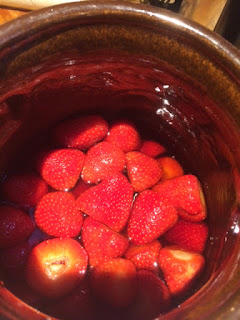I have mentioned many times on this blog that I have a great love for all things porcine. My love is never more true than when dealing with the craft and art of the sausage. When trying out a new butcher I always try their basic traditional sausage first, if this is up to scratch then the rest of their meat is likely to be good too. This simple system has stood me in good stead for many years.
I have also expressed my love of books in the past and in my quest to preserve more meats, the Beautiful Wife bought me and American book called simply
Charcuterie. This book is written by Michael Ruhlman and Brian Polcyn and mine is signed by Mr Ruhlman. It has a forward by the great Thomas Keller (if its good enough for him....). I have dipped into this book often and last month decided to take the plunge and make one of the recipes. I choose the Saucisson Sec recipe as I have some experience of making sausages and it is one of my favourite preserved meats. The results were very pleasing indeed and we have slowly worked our way through the batch I made. Interestingly when I started to see if anyone one else online had used this recipe, I found
Charcuterie all over the place, from blogs to twitter posts, this book appears to be everyone in the States' "go to" preserved meat bible.
Saucisson Sec is one of the memories I brought back from France as a teenager, as I was too scared to bring back the product itself. The chewy, garlicy, pokiness is one of the great treats of the sausage world and that tastes was one of the ways I new I was on holiday.
As ever, I bought my pork from Orchard View Farm in Buckinghamshire (www.orchardviewfarm.co.uk) and my Prague powder #2 from The Coldsmoking Cookery School, just north of Milton Keynes (coldsmoking.co.uk). The recipe below is based on the version in
Charcuterie and I cannot recommend this book highly enough.
Saucisson Sec
5lbs Pork (about 15% Fat)
50 gms Sea salt
1 tblsp Ground black pepper
15 gms sugar
7 gms #2 Prague powder
25 gms minced
1 hog cassing
The pork was ground through a 5 mm plate in a hand mixer (going up to 8 mm wouldn't be a problem). This was mixed with all the other ingredients (except the casing) until it was all fully amalgamated.
 |
| The mix, nicely amalgamated. |
This mix was then stuffed into the casings and made into 15 cm links.
 |
| Linked up and ready to dry. |
The links were stabbed all over with a sterile pin in order that any air might escape and the product might mature evenly. (Please do not do this if you are making traditional English Bangers or you will be left with a sad, dry digit for your breakfast as all the fat will have drained away).
 |
| Drying in my "cellar" |
The sausages were then weighed and hung in my cellar (a re-purposed 6 bottle wine cooler)at 15 degrees c for three weeks.
When they had lost 30% of their weight they were tried for quality. They should be stable at room temperature now but I've kept them at 15 degrees with no apparent lowering of quality.
 |
| Skinned and ready to eat |
The only problem which occurred was a slight stickiness of the skins. This may well have been caused by being a little too clean and my cellar not allowing the "good", white, powdery bacteria to grow on the outside of the sausage. No bacteria grew there!
There are any number of uses for this; from a simple snack to a tasty addition to any kind of braise or rice dish (thin Paella or Risotto, though neither of these are French). Myself and the Beautiful Wife tend to sit down with a glass of beer (sometimes English, sometimes Belgium, sometimes American), some Cheese (often a proper Cheddar, perhaps a piece of Brie, migrating across the board) and some of last year's Pickled Onions (So English that its almost too much!). Bon Appetit! and Happy St George's day tomorrow!










































